Aero Mapping
With aerodynamic development we can make car go faster and faster adding additional downforce on a car, as long as the additional drag associated with it doesn’t have a detrimental effect on the straight-line speed. The most important element of this is the floor and diffuser, as it develops the most efficient downforce with small penalty in drag. But the front and rear wings are the main contributor and key how to tune the car and balance the car correctly. Floor and diffuser can not be changed so easily on the track. In other areas, like the sidepods and front chassis, designers are more focused on limiting negative effects, as they tend to create lift rather than drag because of the way they have to be profiled. The basic principal is that speed and pressure are adversely connected so the faster the air moves, the lower the pressure it has. Check my article about Bernoully equation to know more about how wing work. In Formula One, curving the surfaces of a wing so that the air must move faster along the lower than it does along the upper surface creates a net downward force, which ultimately pushes the tires into the track to create more grip.
Unfortunately, all this downforce comes with negative effect of increased drag, which slows the cars down, and downforce/drag relationship on different wing configurations and knowing these relationships for every single configuration is very important to make fast and precise decisions on the track. You really don't want to guess on the racing day.
Looking at the aero set-up, the driver will want the car to be balanced to a certain point. He may like to drive with the centre of gravity in a certain position, which will generally be different to his team mate. So how does the team cope with this? Guessing is not an option! Well, the two aero devices which can be changed on the car are the front and rear wings, with the rest of the aero set-up being fixed and only modifiable in the long term through wind tunnel testing. The front and rear wings provide massive downforce at each end of the car, and each one can be altered to vary the amount of force it produces.
Each wing has two defining measurements, the chord (the distance between the leading and the trailing edges), and the span (the width of the wing on the car), with the cross section then defining the final shape. After the design of the wing is done, angle of attack defines how much force it will produce. At zero angle of attack, the wing will still produce some downforce because of its design (longer distance underneath than over the top). However, if its angle is increased it will produce more and more downforce, up to certain level. Around this point, the air start to separate from the surface (stall), and the downforce produced will drastically decrease. By varying the angle of attack up to that point, the engineer can fine tune the car.
The front and rear wings are generally made up of two parts - the main plane, and the flaps. The mainplane is the part which creates the main bulk of the downforce, and is at a fixed angle of attack. The fine-tuning does not come from the mainplane, but from the flaps. Varying amounts of downforce can be obtained by changing the flap angle, and it is the half degree change of angle on flap which is used to fine tune the car. Angle of the flap can be simple to change with "screwdriver-like" type device, and it can be changed without losing time during a pit stop. In the same way, rear wing tuning with angle of the flap can add or reduce downforce on the rear of the car. So, the complexities of aerodynamics allow the engineers to get a different force from the same wing.
Although a racing car’s basic shape and general aerodynamic performance are first sketched out on the designer’s computer, this is only the beginning. During the development, every team spends many hours in the wind tunnel using a model of the car with many different components, and testing a hundreds of different configurations. Team will run a hundreds of aerodynamic trims and look at lift/drag trade-offs, predict ride heights and alter the suspension setup so that you are getting the best out of the car's aerodynamics at different trims and try to gain a better understanding of what and how affects your car's performance and why on any of tested configurations, carefully ‘mapping’ the results. Same procedure is performed for each different wing design and car configuration. Regression models were created for each of the responses to provide aerodynamic prediction and optimization capabilities. The aero map shows how the wing elements and ride heights on a racing car perform in different settings in terms of lift and drag. Everything is carefully recorded and data tables are created. Each wing or configuration has his own aero map.
A plot of drag vs. downforce of an entire map |
Aero map will be taken to the circuit by the race engineer. Race engineers can then use these maps to help them choose the best settings for a particular wing on particular circuit. This tells him the most efficient way of obtaining a certain level of downforce or performance using the wing elements he has. If the driver wants more downforce on the rear, it shows him how best to achieve it, and then what angle of flap is required on the front wing to balance this change. It's all there on paper! Map is used to determine the effect of every single change of front ride height, car rake, front wing angle, rear wing angle, gurney flap height and yaw angle on the front downforce, rear downforce, drag and lift-to-drag ratio of the car. Basically, an aero map is aerodynamic data, signature of the specific car configuration, numbers on a piece of paper, or more likely in a computer.
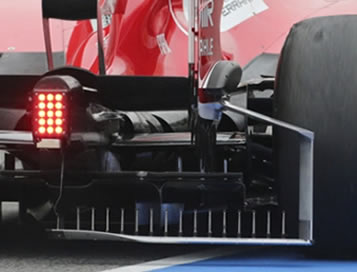 On the track, data aero mapping is used to correlate in real time what the wind tunnel figures say about aero element. The pace of development of Formula One cars is so rapid that seldom does a Formula One car go to a race without some aero updates. With the limitations on and the new aerodynamic regulations and testing all the teams are working hard to make the most of the track time before the season starts. That's why some teams like to correlate data from the wind tunnel with real life data on the track. During track aero mapping teams will use multiple sensors to measure the downforce generated at various speeds, laser ride height sensors and suspension force transducers. A slightly less technical solution is use of flow-vis paint. This is a common practice in the last few years and is used to confirm the wind tunnel readouts and maps. The aero maps
On the track, data aero mapping is used to correlate in real time what the wind tunnel figures say about aero element. The pace of development of Formula One cars is so rapid that seldom does a Formula One car go to a race without some aero updates. With the limitations on and the new aerodynamic regulations and testing all the teams are working hard to make the most of the track time before the season starts. That's why some teams like to correlate data from the wind tunnel with real life data on the track. During track aero mapping teams will use multiple sensors to measure the downforce generated at various speeds, laser ride height sensors and suspension force transducers. A slightly less technical solution is use of flow-vis paint. This is a common practice in the last few years and is used to confirm the wind tunnel readouts and maps. The aero maps 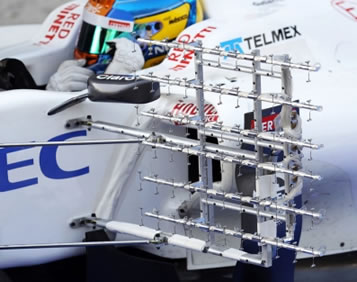 created on track will be vital in helping the race engineers to find any peace of wind tunnel aero map data which not corresponding with real life and with that the perfect setup for race day.
created on track will be vital in helping the race engineers to find any peace of wind tunnel aero map data which not corresponding with real life and with that the perfect setup for race day.
Aero mapping can be done on the track also. For aero mapping on the race track different sensors are used. The idea is simple: through controlled setup they have to find out and understand aero behavior in different airflows. This is a useful data when you plan to use different wings, ride height parameters, and in general to measure flow around the different parts of the car. Lasers are used to constantly measure a ride height on each corner of the car.
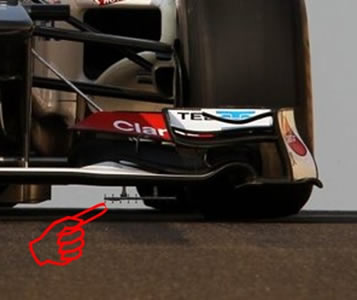 The aero rake (aero rig, an array of sensors) could be used for measuring air speed, angle flow, pressure (Pitot-Static probe) and even temperature on precise and specific positions. Multiple rows of rakes are used and these are securely mounted on different parts of the car. Sensors on this aero rake are collecting data on body wake and thus creating effective and data-rich info sheet. Points of use of aero rake could often be seen in front or behind the tires, or on top or right behind the sidepods, behind diffuser or rear wing for example. These rigs are custom shaped very expensive sensors grids. Force IndiaRed Bull and McLaren spent some time using a complex motorized and adjustable air speed Kiel Probe sensor array measuring the pressure field behind front tire. Height of array can be changed during
The aero rake (aero rig, an array of sensors) could be used for measuring air speed, angle flow, pressure (Pitot-Static probe) and even temperature on precise and specific positions. Multiple rows of rakes are used and these are securely mounted on different parts of the car. Sensors on this aero rake are collecting data on body wake and thus creating effective and data-rich info sheet. Points of use of aero rake could often be seen in front or behind the tires, or on top or right behind the sidepods, behind diffuser or rear wing for example. These rigs are custom shaped very expensive sensors grids. Force IndiaRed Bull and McLaren spent some time using a complex motorized and adjustable air speed Kiel Probe sensor array measuring the pressure field behind front tire. Height of array can be changed during 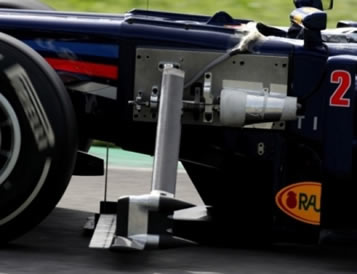 the drive in precise way. This test equipment will traverse vertically during a run to capture the complete wake off the front tire for correlation with wind tunnel and computational fluid dynamics (CFD) data – this is crucial to make sure that the development process is working efficiently. Picture of the array is below in its low position.
the drive in precise way. This test equipment will traverse vertically during a run to capture the complete wake off the front tire for correlation with wind tunnel and computational fluid dynamics (CFD) data – this is crucial to make sure that the development process is working efficiently. Picture of the array is below in its low position.
The driver will then run at a fixed speed along the straight. Keeping a consistent speed will create an aero map of flow across the body and ensure the data is consistent (or not) with data from wind tunnel and CFD. The data from the tests will be used to direct the team in deciding how the wing should work.
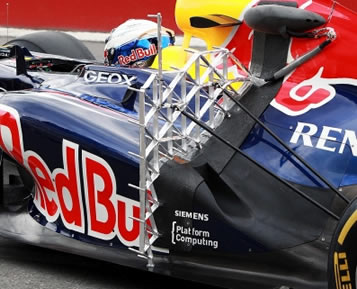 Aerodynamic mapping can also serve as a mathematical model for numerical lap simulations and aero components evaluation. They are able to import an aero map of a component into the simulator and evaluate its feel or effect on the balance of the car. Because it is just a set of numbers, the aero map can be loaded into a simulator for testing and assessing how a component feels for the driver.
Aerodynamic mapping can also serve as a mathematical model for numerical lap simulations and aero components evaluation. They are able to import an aero map of a component into the simulator and evaluate its feel or effect on the balance of the car. Because it is just a set of numbers, the aero map can be loaded into a simulator for testing and assessing how a component feels for the driver.
So basically, engineers can create an imaginary wing aero map, all theoretical, nothing physical. Based on those numbers, they are able to achieve test runs on simulator, asses an imaginary wing and actually never race with that. In the same manner multiple parameters can be displayed, derived from the base suspension, chassis, tires, aerodynamics, etc. These results are also available in table format as data values, so that you can export them and pass the output to chart-drawing software.
To know more about mapping, check my other articles:
Back to the top of the page







